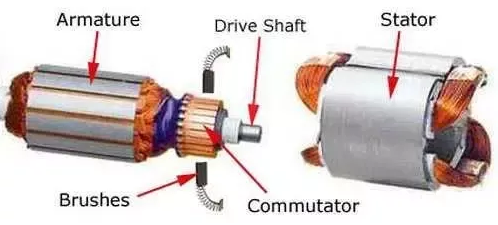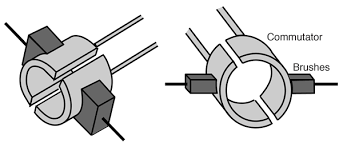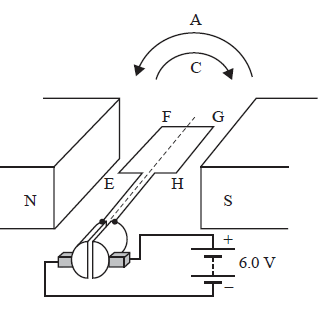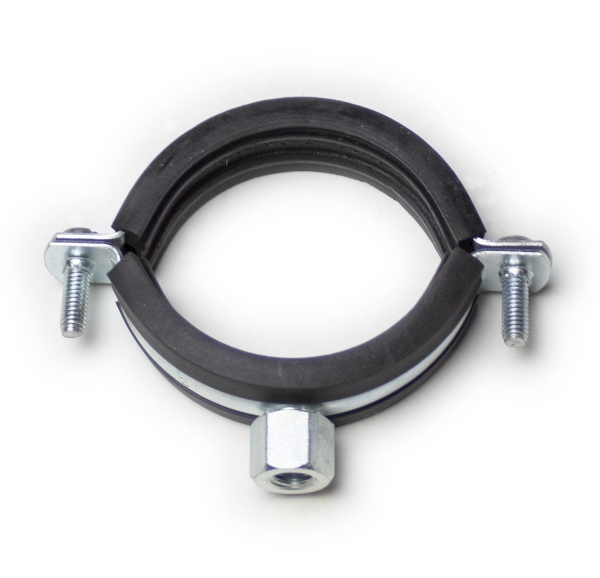Unravel the intricacies of split ring commutators, their significance in the realm of DC motors and generators, and the future direction of this essential component. From design to real-world applications, this article sheds light on all aspects of split ring commutators.
Introduction to Split Ring Commutators
In the realm of electrical machinery, few components compare in importance to the split ring commutator. So, what exactly is a split ring commutator, and why is it as critical as it is? A split ring commutator – typically made from a conductive material such as copper and segmented into two or more parts with insulating materials – is at the heart of many electromechanical devices. Its primary function is to “commutate” or reverse the direction of current in the coil of a generator or motor, ensuring that the mechanical torque or motion remains in one direction while the current cyclically changes direction.
In its inception, the split ring commutator was an inventive response to the limitations of early electric motors, which relied on alternating current (AC). While AC motors were the pioneers of electrically induced rotational motion, their main constraint was they could not provide a steady, single-direction rotation due to the continually alternating nature of the electric current supplied.
Enter the split ring commutator. With its ability to reverse the current direction at just the right moments – in sync with the rotation – it allowed the use of direct current (DC) and ensured single-direction rotation irrespective of the changes in the current direction. This innovation led to the advent of Direct Current (DC) motors and generators, which birthed a new era in the field of electrical power machinery.
The split ring commutator is primarily deployed in the construction of DC motors and generators, serving as a coupling mechanism between the motor’s spinning rotor and the stationary stator. It is a critical intermediary, supplying the rotor windings with current and efficiently translating electrical energy into a mechanical force – or vice versa, depending on whether the device is operating as a motor or a generator.
The extensive use of DC machines in various sectors – from industry to transport to household appliances – further underlines the critical role of the split ring commutator. Its function forms the backbone of many systems vital for everyday life and industrial processes, reinforcing its importance in the field of electrical engineering.

Design and Construction of Split Ring Commutators
Upon understanding the rationale and utility of the split ring commutator, we can better appreciate the simplicity yet sophistication of its design and construction. At its core, the split ring commutator comprises a metal ring, typically made from copper due to its excellent electrical conductivity properties, “split” into two or more separate segments.
The physical features and design of a split ring commutator are dictated primarily by its function in a DC motor or generator. The core part of a commutator, the copper ring, is usually split into two halves to use in smaller DC machines. However, for larger commercial motors and generators, it could be segmented further. Each segment seems like a protruding semi-circular metal piece when viewed from the side. The segments are mounted on an insulating cylinder in such a fashion that the cylinder rotates along with the shaft of the motor or generator. The separate segments, while physically distinct, are electrically linked to the rotating coil of the DC machine.
Between these copper segments, an insulating material is placed. Mica is a common choice due to its superior insulating features, its ability to withstand high temperatures, and its resilience to the wearing down process due to the regular movement of the brushes against the commutator. This insulating material ensures the electrical separation of the copper segments, a critical feature that allows the commutator to perform its function of reversing the direction of the current flawlessly.
On the periphery of these segments, carbon brushes are in constant contact. The brushes, made out of carbon due to its self-lubricating nature and excellent thermal stability, bridge the connection between the rotating commutator (and the rotor windings it’s connected to) and the stationary parts of the motor or generator.
The construction of a split ring commutator is a meticulous balancing act between ensuring electrical continuity and enabling a system of controlled intermittent disconnections. Despite its relative mechanical simplicity, the careful choice of the materials used for its construction, coupled with its considered design, enables the split ring commutator to play a foundational role in the operation of DC motors and generators.

The Function and Operation of Split Ring Commutators
Understanding the pivotal role of split ring commutators in Direct Current (DC) generators and motors requires an in-depth exploration of their operation. Their strategic role in reversing the direction of current within the motor’s or generator’s coils is instrumental in preserving the constant direction of rotation – a key feature that illustrates the underlying genius of the commutator’s design.
The electromotive force in the rotating coil caused by its motion within a magnetic field follows a sinusoidal pattern – rising to a peak and then falling to zero before reversing its direction to peak negatively. Were the coil connected directly to a load in this instance, the motor’s (or generator’s) output current would alternate direction in the same way – a characteristic feature of alternating current (AC). Still, this gives rise to bidirectional rotation, which is not conducive to most applications where consistent unidirectional movement is desired.
Here is where the function of a split ring commutator comes to the fore. In a DC motor or generator, each end of the coil is connected to a separate segment of the split ring commutator. As the coil rotates in the magnetic field, the carbon brushes – in constant contact with the rotating commutator – pick up the current generated and direct it to the external circuit.
The key aspect of the operation of the commutator lies in the segmentation of the split ring. As the coil crosses the zero points in its sinusoidal electromotive force profile, the commutator simultaneously “breaks” the previous electrical connection and “makes” a new one. It does so in such a way that each brush is always connected to the same coil end, maintaining a steady direction of current in the external circuit, irrespective of the alternations happening inside the coil.
This ingenious mechanism ensures that despite the cyclic nature of the electromotive force in the coil and periodically alternating current direction within the coil, the output current is consistently directed in one way. This uniform output is what differentiates a DC motor or generator from its AC counterparts. This operation is the basis of the commutation process, hence the name “commutator” – a creation that allows the rotational motor torque or the generator power to maintain a steady, unidirectional flow, enhancing the usability and efficiency of these devices.

The Role of Split Ring Commutators in Power Generation
The importance of the split ring commutator in power generation, particularly in DC generators, cannot be understated. Indeed, it’s the unsung protagonist in a play of electrical and mechanical energies, crucially directing the plot at every turn.
At the core of power generation in a DC generator, an essential process occurs the conversion of mechanical energy into electrical energy. This transmutation is made possible through a principle known as electromagnetic induction. It states that a fluctuating magnetic field, induced by a rotating coil in the magnetic field, gives rise to an electromotive force or voltage. As the coil spins, it cuts across the magnetic field lines, prompting a flow of current.
However, this current generated in the coil (armature) of the generator is inherently alternating due to the sinusoidal nature of electromagnetic induction. While useful in certain scenarios, this AC isn’t compatible with many applications that require a steady, direct current, such as battery charging, powering DC equipment, and more.
Enter the split ring commutator. Its function here is multi-faceted yet succinct: it converts the internally generated AC into a unidirectional DC output, thereby ensuring that the electricity supplied to the external circuit is always in a single, forward direction. It does this efficiently by “switching” the contacts between the brushes and the coil ends at every half-turn of the coil rotation.
First, it rectifies the alternating current, changing the alternating direction of current flow to one continuous path—second, it accommodates the changes in coil direction without disrupting the direction of the resulting electric power.
In doing so, it ensures that the energy produced by the generator can be used efficiently and safely in a broad range of devices, including appliances, vehicles, and comprehensive electrical systems that rely on direct current. Moreover, mitigating the need for any external rectification of the current, simplifies the power generation system, lending robustness and reliability to the process.
Without the split ring commutator in a DC generator, we would lack the ability to harness and utilize the power generated consistently and predictably in systems that require direct current. As such, the commutator doesn’t just play a part in power generation – it’s a pivotal character that directs the flow of the story, making it coherent, usable, and adaptable to a plethora of needs.
Considerations When Choosing a Split Ring Commutator
When considering the ideal split ring commutator for a specific application, several crucial factors come into play. The selection process is not a one-size-fits-all affair, rather it demands an understanding of the specific application requirements and the performance parameters of the commutator to ensure optimal performance and longevity of the DC machine.
- Intended Application: This alludes to the sort of machine (motor or generator) and the specific use case. For instance, a high-torque power tool may require a robust commutator that can withstand high rotational speeds, while a small toy motor may be adequately served by a simpler, low-cost commutator.
- Current and Voltage Ratings: The commutator must be built to accommodate the specific current and voltage requirements of the application. Higher current loads will necessitate a larger commutator (with more segments) to distribute the load evenly and prevent overheating.
- Rotational Speed: High rotational speeds call for durable materials and precise construction to prevent signs of wear and tear. Moreover, a higher number of segments can help reduce sparking and ensure smoother operation when running at higher speeds.
- Environment: The general operating environment also partially determines the choice of a commutator. A commutator for a DC machine exposed to harsh conditions should be made of materials capable of withstanding such conditions without degradation.
The performance of the split ring commutator itself is largely dependent on two facets: material selection and construction quality. The materials used in the commutator, from the copper segments to the insulating material, directly influence its electrical conductivity, thermal stability, and durability. Commutators should ideally be constructed from materials that resist heat, conduct electricity well, and hold up under friction. In addition, durability under the constant wear of the carbon brushes is a significant consideration.
The construction quality also directly affects the function of the commutator. A well-built commutator should have a smooth, unbroken surface for the brushes to maintain regular contact. Moreover, there should be perfect alignment between the commutator segments and the coil connections to ensure a successful reversal of the current at the precise moment needed.
In conclusion, selecting a split ring commutator is a decision that demands a keen understanding of the specific application along with an appreciation for the material and construction quality. The science and art of picking the right commutator are crucial for ensuring the length and quality of service life of your DC machines.
Common Problems and Maintenance Requirements of Split Ring Commutators
Split ring commutators, given their significant role in the operation of electric DC machines, require a keen eye on maintenance and an understanding of possible wear and tear issues to ensure long and smooth service life. Situated at the center of mechanical motion and electrical activity, these components endure substantial strain and degradation over time.
One of the most common issues is wear and tear on the commutator segments and carbon brushes. The constant friction between the moving parts can gradually degrade the materials, changing their shape or size and eventually affecting machine performance. This effect may manifest as irregular sparking, fluctuating machine speeds, or reduced operational efficiency.
Another prevalent concern is the formation of oxide layers or surface contaminants on the commutator’s conducting segments. This can be caused due to the corrosion of materials, dust or dirt infiltration, or even the products of brush wear and combustion. These contaminants can interrupt the smooth electrical contact between the brushes and the commutator, leading to fluctuation in machine performance.
Over time, problems like thermal expansion, which can cause the material of the commutator to distort or warp, can also occur. This variant can cause irregularities in the contact between the brushes and the commutator, leading to inefficient operation and, in severe cases, potential machine damage.
The maintenance of split ring commutators is as crucial as addressing the above concerns. Regular inspection of commutators and brushes for signs of wear and tear, surface contamination, or distortion is key to prolonging the commutator’s effective lifespan.
The carbon brushes should be replaced periodically, even before they wear out entirely to prevent potential damage to the commutator. If wear and tear on the commutator surface is noted, it may be required to ‘turn’ or resurface the commutator – a process where a thin layer of the commutator’s surface is removed to restore it to a uniform and smooth condition.
It’s also important to maintain clean working conditions for the machines to prevent dust or dirt from accumulating on the commutator surface. Moreover, the appropriate alignment and pressure of the brushes on the commutator should be double-checked regularly – excess pressure can speed up wear, while insufficient pressure can lead to sparking and irregular machine operation.
In conclusion, regular maintenance and a proactive approach to addressing common problems can significantly extend the lifespan of a split ring commutator, revamping its performance and the overall operational efficiency of the DC machine. Awareness of these points will be essential in alleviating day-to-day user concerns, thus ensuring long and harmonious service.
Case Studies of Split Ring Commutator Use
The applicability of split ring commutators spans broadly across an array of industries and technologies, each exhibiting unique challenges and opportunities for performance optimization. This section aims to dive into a comprehensive analysis of a few real-world applications where split ring commutators are instrumental, spotlighting their pivotal role while ministering to the finer nuances of challenges, advantages, and potential improvements.
- Automotive Industry: DC motors with split ring commutators are widely employed in vehicles for applications like power windows and windshield wipers. While these systems benefit immensely from the direct, stable power provided by the commutator, they’re often exposed to harsh environmental conditions, causing concerns related to durability. Patterns indicate a potential shift towards brushless DC motors to alleviate wear and tear while maintaining the advantages of direct current.
- Toy Manufacturing: Innumerable toys, especially those with moving parts, employ miniature DC motors with split ring commutators. Though the simplicity and cost-efficiency of these commutators are advantageous, issues such as sparking, carbon brush replacement and oxide layer formation can be common. An improvement could be made in the materials used for construction, focusing on enhancing durability and reducing maintenance.
- Home Appliances: Devices like mixer grinders, fans, and vacuum cleaners often employ DC motors with commutators. These applications require stable power and long operation hours. However, noise generation due to the brush-contact interface and the continuous wear and tear can be shortcomings. Techniques like regular component cleaning and carbon brush replacement can extend the life of these appliances.
- Industrial Machinery: Various heavy-duty machinery and industrial-grade tools like drills and grinders rely on the robustness of DC motors fitted with split ring commutators. These commutators provide the predictable, direct current required for such demanding tasks. However, heavy usage puts strain on the commutator. Ensuring the use of high-quality, durable materials can mitigate potential issues.
Delving into these real-world cases allows an understanding of the versatile and adaptable nature of split ring commutators. They play a pivotal role in various applications, operating as the silent workhorse, tirelessly supplying a steady provision of direct current electricity. However, they’re not exempt from weaknesses. By investing time in confronting these challenges and dedication towards effective improvements, we can ensure the enduring relevance of split ring commutators in the future landscape of power generation and utilization.
Future Trends in Split Ring Commutator Technology
Looking into the future, it is evident that split ring commutator technology, an integral part of many electrical systems, is not static. We foresee key advancements in materials, construction techniques, and maintenance strategies that could significantly reshape the landscape of commutator use.
Advanced Material Application: One of the more immediate advancements likely to come about relates to materials technology. High-performance, more durable materials for both brushes and commutators can lead to better wear resistance, more thermal stability, and hence longer lifespans, even under high operational loads. The development of better insulating materials is also expected, aimed at reducing premature failure due to insulation breakdown.
Micro-precision Manufacturing: Technological leaps in precision manufacturing could also manifest in commutator construction. For instance, using micromachining or additive manufacturing techniques to build commutators could result in higher precision construction with fewer defects, enhancing overall device performance and usability.
Smart Monitoring and Predictive Maintenance Techniques: The integration of sensors and Internet of Things (IoT) technology into electrical machines presents a significant opportunity to collect real-time data on commutator performance. This advancement could pioneer intelligent monitoring systems alerting users about potential issues like excessive wear, high temperatures, or changes in brush contact quality before they could cause catastrophic damage. Such predictive maintenance techniques could drastically reduce downtime and extend the effective lifespan of electrical machines.
Transition towards Brushless Technology: While the tradition of split ring commutators stands firm, a noteworthy shift has begun towards brushless DC motors and universal AC/DC motors for some applications. These devices enable similar functionality but reduce maintenance requirements and potential power losses due to brush friction.
All these trends and advancements paint a promising future for split ring commutator technology, extending its relevance and enhancing its performance. These journeys and potential transformations become even more critical in the context of our growing reliance on electrical appliances and systems. While these changes are imminent, the core characteristics of the split ring commutator, namely its robustness and ability to consistently provide direct current power, are hoped to be maintained and further improved upon as we step into the future.
Conclusion
Split ring commutators play an invaluable role in various electrical devices by ensuring a seamless conversion of generated power. This article has addressed the key features, operation, importance, selection, maintenance, case studies, and forthcoming advancements of commutator technology. As new trends emerge, split ring commutators will continue to have a significant impact on the electrical field.


